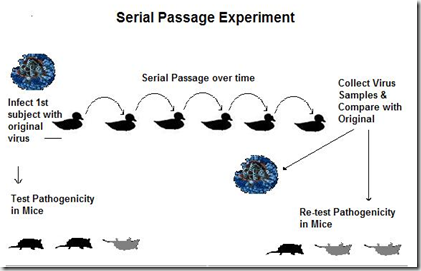[Source: Journal of Virology, full page: (LINK). Abstract, edited.]
Airborne Transmission of Highly Pathogenic H7N1 Influenza in Ferrets
Troy C. Sutton 1#, Courtney Finch 1, Hongxia Shao 1, Matthew Angel 1, Hongjun Chen 1, Ilaria Capua 2, Giovanni Cattoli 2, Isabella Monne 2 and Daniel R. Perez 1#
Author Affiliations: <SUP>1</SUP>Department of Veterinary Medicine, University of Maryland, College Park, and Virginia-Maryland College of Veterinary Medicine, Maryland Campus, 8075 Greenmead Drive, College Park, Maryland, 20742, USA; <SUP>2</SUP>Istituto Zooprofilattico Sperimentale delle Venezie, Viale dell?Universit?, 10 Legnaro, Padova 35020, Italy
ABSTRACT
Avian H7 influenza viruses are recognized as potential pandemic viruses as personnel often become infected during poultry outbreaks. H7 infections in humans typically cause mild conjunctivitis; however, the H7N9 outbreak in the spring of 2013 has resulted in severe respiratory disease. To date, no H7 viruses have acquired the ability for sustained transmission in humans. Airborne transmission is considered a requirement for the emergence of pandemic influenza, and advanced knowledge of the molecular changes or signature required for transmission would allow early identification of pandemic vaccine seed stocks, screening and stockpiling of antiviral compounds, and focused eradication efforts on flocks harboring threatening viruses. Thus, we sought to determine if a highly pathogenic influenza A H7N1 (A/H7N1) virus, with no previous history of human infection, could become airborne transmissible in ferrets. We show that after 10 serial passages, A/H7N1 developed the ability to transmit to co-housed and airborne contact ferrets. Four amino acid mutations (PB2 T81I, NP V284M, M1 R95K, and Q211K) in the internal genes and a minimal amino acid mutation (K/R313R) in the stalk region of the HA protein were associated with airborne transmission. Furthermore, transmission was not associated with a loss of virulence. These findings highlight the importance of the internal genes in host adaptation and suggest that natural isolates carrying these mutations be further evaluated. Our results demonstrate that a highly pathogenic avian H7 virus can become airborne transmissible in a mammalian host, and support on-going surveillance and pandemic H7 vaccine development.
Importance:
The major findings of this report are that a highly pathogenic strain of H7N1 avian influenza can be adapted to become airborne transmissible in mammals without mutations altering the receptor specificity. Changes in receptor specificity have been shown to play a role in the ability of avian influenza viruses to cross the species barrier and these changes are assumed to be essential. The work herein challenges this paradigm, at least for the influenza viruses of the H7 subtype, which have recently become the focus of major attention as they have crossed to humans.
FOOTNOTES
#Correspondence to: Dr. Daniel R. Perez, e-mail: dperez1@umd.edu, telephone: 301-314-6811
#Dr. Troy C. Sutton, e-mail: suttontroy27@gmail.com, telephone: 301-314-6678
Copyright ? 2014, American Society for Microbiology. All Rights Reserved.
-
------
Airborne Transmission of Highly Pathogenic H7N1 Influenza in Ferrets
Troy C. Sutton 1#, Courtney Finch 1, Hongxia Shao 1, Matthew Angel 1, Hongjun Chen 1, Ilaria Capua 2, Giovanni Cattoli 2, Isabella Monne 2 and Daniel R. Perez 1#
Author Affiliations: <SUP>1</SUP>Department of Veterinary Medicine, University of Maryland, College Park, and Virginia-Maryland College of Veterinary Medicine, Maryland Campus, 8075 Greenmead Drive, College Park, Maryland, 20742, USA; <SUP>2</SUP>Istituto Zooprofilattico Sperimentale delle Venezie, Viale dell?Universit?, 10 Legnaro, Padova 35020, Italy
ABSTRACT
Avian H7 influenza viruses are recognized as potential pandemic viruses as personnel often become infected during poultry outbreaks. H7 infections in humans typically cause mild conjunctivitis; however, the H7N9 outbreak in the spring of 2013 has resulted in severe respiratory disease. To date, no H7 viruses have acquired the ability for sustained transmission in humans. Airborne transmission is considered a requirement for the emergence of pandemic influenza, and advanced knowledge of the molecular changes or signature required for transmission would allow early identification of pandemic vaccine seed stocks, screening and stockpiling of antiviral compounds, and focused eradication efforts on flocks harboring threatening viruses. Thus, we sought to determine if a highly pathogenic influenza A H7N1 (A/H7N1) virus, with no previous history of human infection, could become airborne transmissible in ferrets. We show that after 10 serial passages, A/H7N1 developed the ability to transmit to co-housed and airborne contact ferrets. Four amino acid mutations (PB2 T81I, NP V284M, M1 R95K, and Q211K) in the internal genes and a minimal amino acid mutation (K/R313R) in the stalk region of the HA protein were associated with airborne transmission. Furthermore, transmission was not associated with a loss of virulence. These findings highlight the importance of the internal genes in host adaptation and suggest that natural isolates carrying these mutations be further evaluated. Our results demonstrate that a highly pathogenic avian H7 virus can become airborne transmissible in a mammalian host, and support on-going surveillance and pandemic H7 vaccine development.
Importance:
The major findings of this report are that a highly pathogenic strain of H7N1 avian influenza can be adapted to become airborne transmissible in mammals without mutations altering the receptor specificity. Changes in receptor specificity have been shown to play a role in the ability of avian influenza viruses to cross the species barrier and these changes are assumed to be essential. The work herein challenges this paradigm, at least for the influenza viruses of the H7 subtype, which have recently become the focus of major attention as they have crossed to humans.
FOOTNOTES
#Correspondence to: Dr. Daniel R. Perez, e-mail: dperez1@umd.edu, telephone: 301-314-6811
#Dr. Troy C. Sutton, e-mail: suttontroy27@gmail.com, telephone: 301-314-6678
Copyright ? 2014, American Society for Microbiology. All Rights Reserved.
-
------

Comment